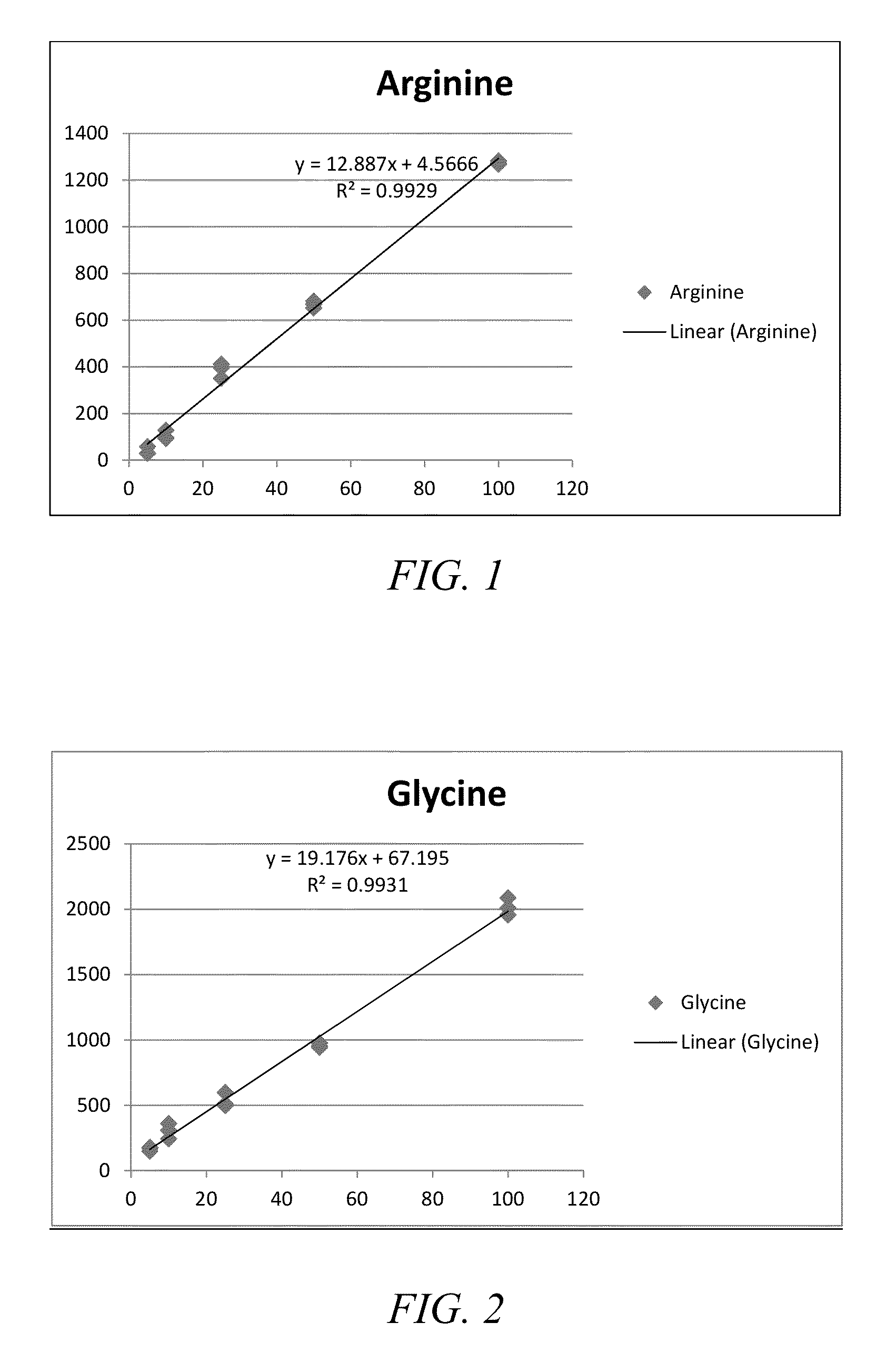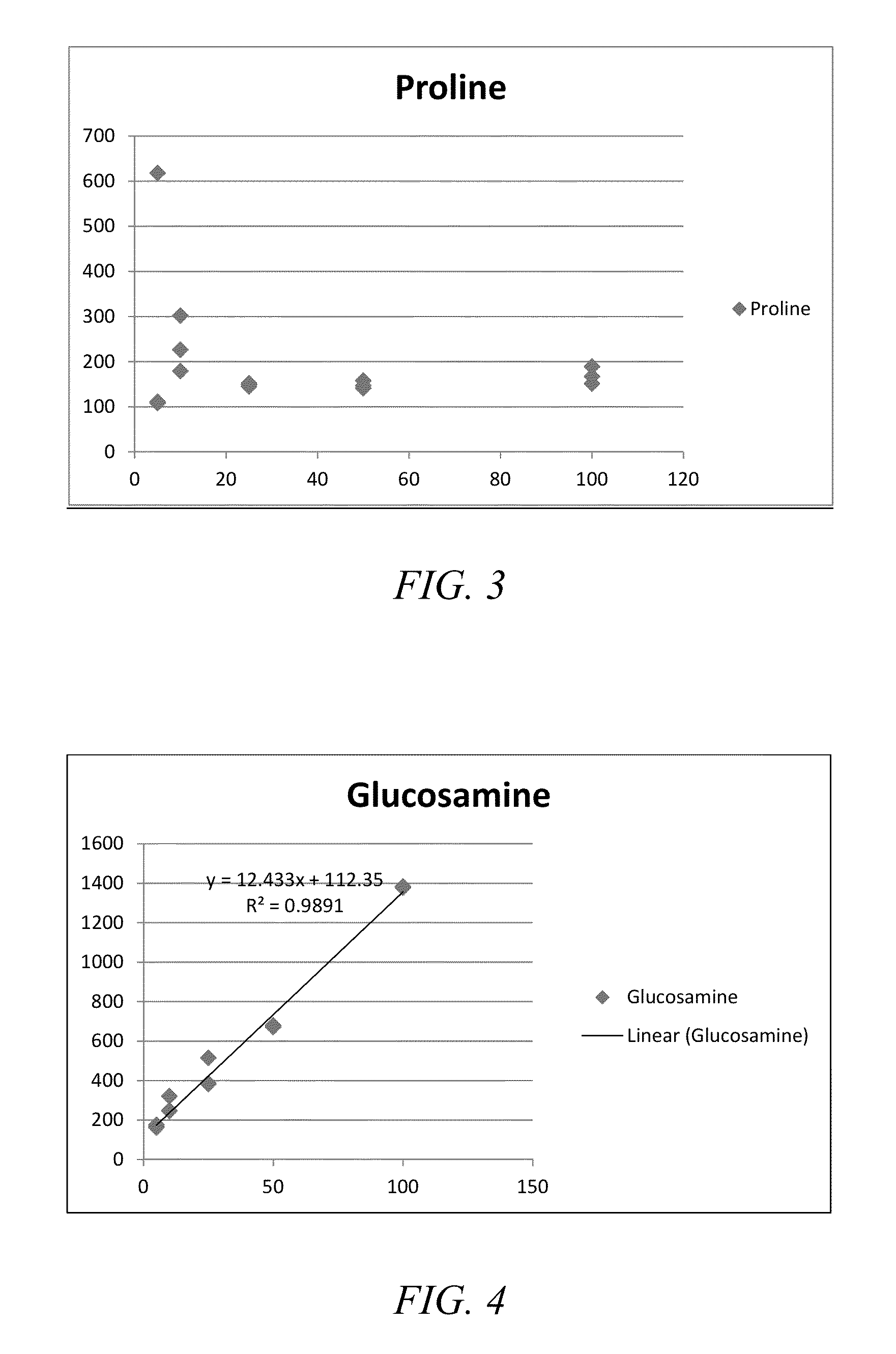System and process for quantifying potentially mineralizable nitrogen for agricultural crop production
a technology of agricultural crop production and fluorometric measurement, applied in the direction of fluorescence/phosphorescence, material analysis, instruments, etc., can solve the problems of increasing the lodging potential, requiring additional input costs, and no analytical methods used
- Summary
- Abstract
- Description
- Claims
- Application Information
AI Technical Summary
Benefits of technology
Problems solved by technology
Method used
Image
Examples
example 1
Calibration Curves of Pure Amino Acids and Amino Sugars
[0041]A split-plot design was utilized with product being the main plot and rate being the sub-plot was replicated three (3) times. The products in this example were amino acids arginine, asparagine, glutamine, glycine, lysine and proline, and the amino sugars were glucosamine, mannosamine, galactosamine and N-Acetyl-Glucosamine. The experiment included concentrations of varying magnitudes, namely between 0, 5, 10, 25, 50 and 100 μM. The results of Example 1 are illustrated in FIGS. 1 through 4, which highlight that the system and process disclosed herein quantifies the compounds that are important for nitrogen mineralization in the soil. In addition, the system and process disclosed herein can provide an estimate of potentially mineralizable nitrogen. These results from Example 1 show that the flourescent system and process is accurate in quatifying the concentration of amino acids and amino sugars in a KCl matrix. The system a...
example 2
Standard Addition of NH4+ to Determine Level of Interference
[0043]In this example, a full factorial design was utilized for the products of glycine, glutamine, glucosamine and galactosamine, with four (4) different ammonium (NH4+) concentrations replicated three (3) times. The ammonium concentrations for this example varied between 0, 250, 500, 750 and 1000 μM. These concentrations include common NH4+ that might be found in agricultural soils within the United States.
[0044]As illustrated in FIG. 5, when a known amount of ammonium was added to a known amount of amino acid or amino sugar, the RFU from the combination should be equal to the sum of the individual RFU units. This demonstrates that the influence of measuring these two compounds simultaneously is an additive effect and that there is no need to make any adjustments for calibration using the system and process for quantifying potentially mineralizable nitrogen for agricultural crop production.
[0045]The results of this experi...
example 3
Evaluation of Aliquot Volume on Quantification of Free Amino Acids and Amino Sugars in a 2M KCl Soil Extract
[0047]In this experiment, a full factorial design with eight (8) soils and (5) aliquot volumes were replicated (3) times. Soils had a wide range of both total nitrogen (TN) and total carbon (TC) values with similar concentrations of inorganic nitrogen. In this experiment, aliquot volumes varied between 20, 60, 80, 100 μL of 10:1 2M KCl extract. A 10:1 KCl:soil ratio was chosen for this example because it is a commonly used extraction ratio and would introduce the least potential for background or matrix interference.
[0048]As illustrated in FIG. 6, as the aliquot volume was changed, the amount of nitrogen contained in the sample was changed. Correspondingly, as the amount of nitrogen increases (with increasing aliquot volume), within a specific soil series there is a very strong linear relationship between aliquot volume and RFU indicating that the calibration curves discussed ...
PUM
| Property | Measurement | Unit |
|---|---|---|
| volume | aaaaa | aaaaa |
| volume | aaaaa | aaaaa |
| depth | aaaaa | aaaaa |
Abstract
Description
Claims
Application Information
 Login to View More
Login to View More - R&D
- Intellectual Property
- Life Sciences
- Materials
- Tech Scout
- Unparalleled Data Quality
- Higher Quality Content
- 60% Fewer Hallucinations
Browse by: Latest US Patents, China's latest patents, Technical Efficacy Thesaurus, Application Domain, Technology Topic, Popular Technical Reports.
© 2025 PatSnap. All rights reserved.Legal|Privacy policy|Modern Slavery Act Transparency Statement|Sitemap|About US| Contact US: help@patsnap.com



